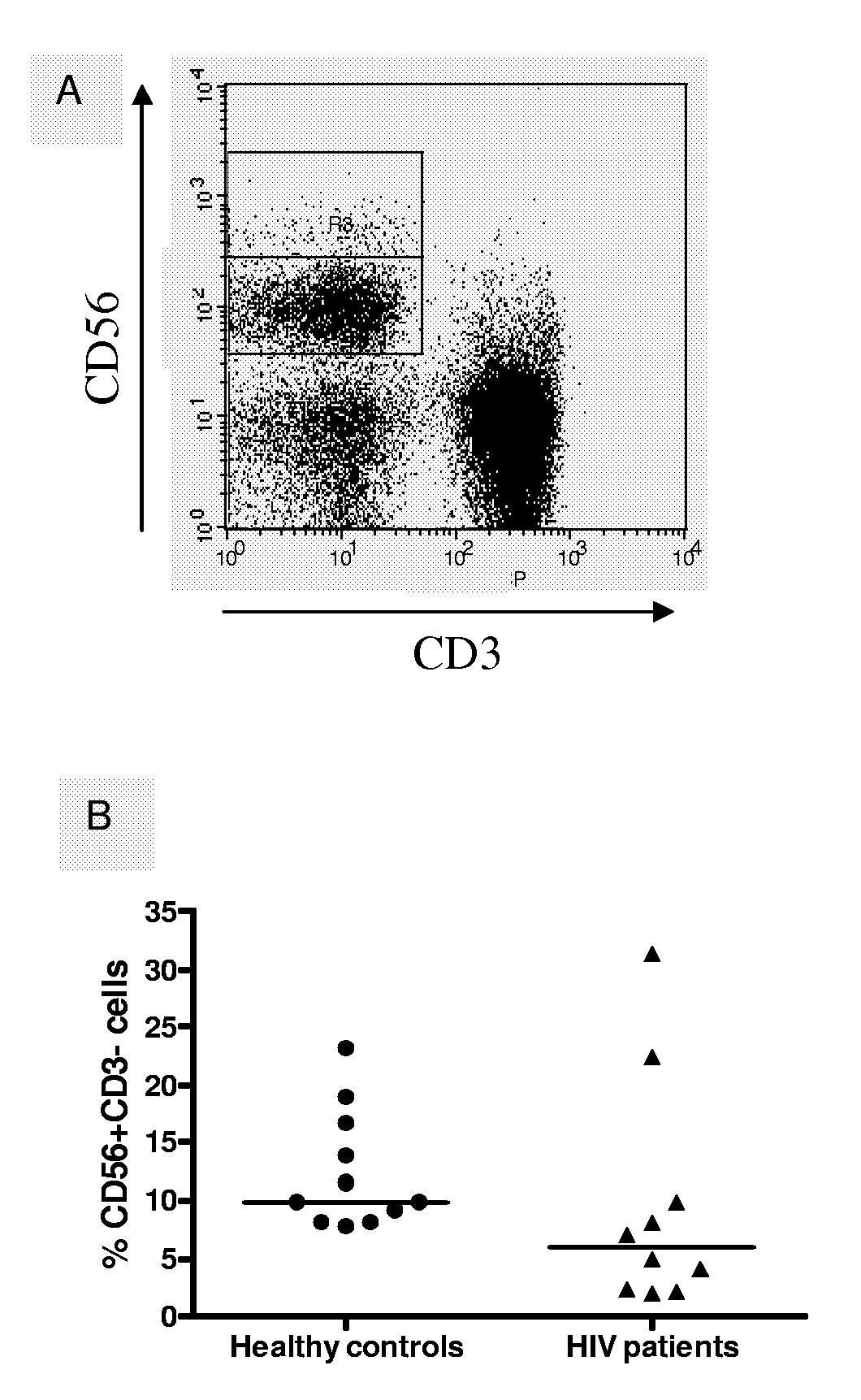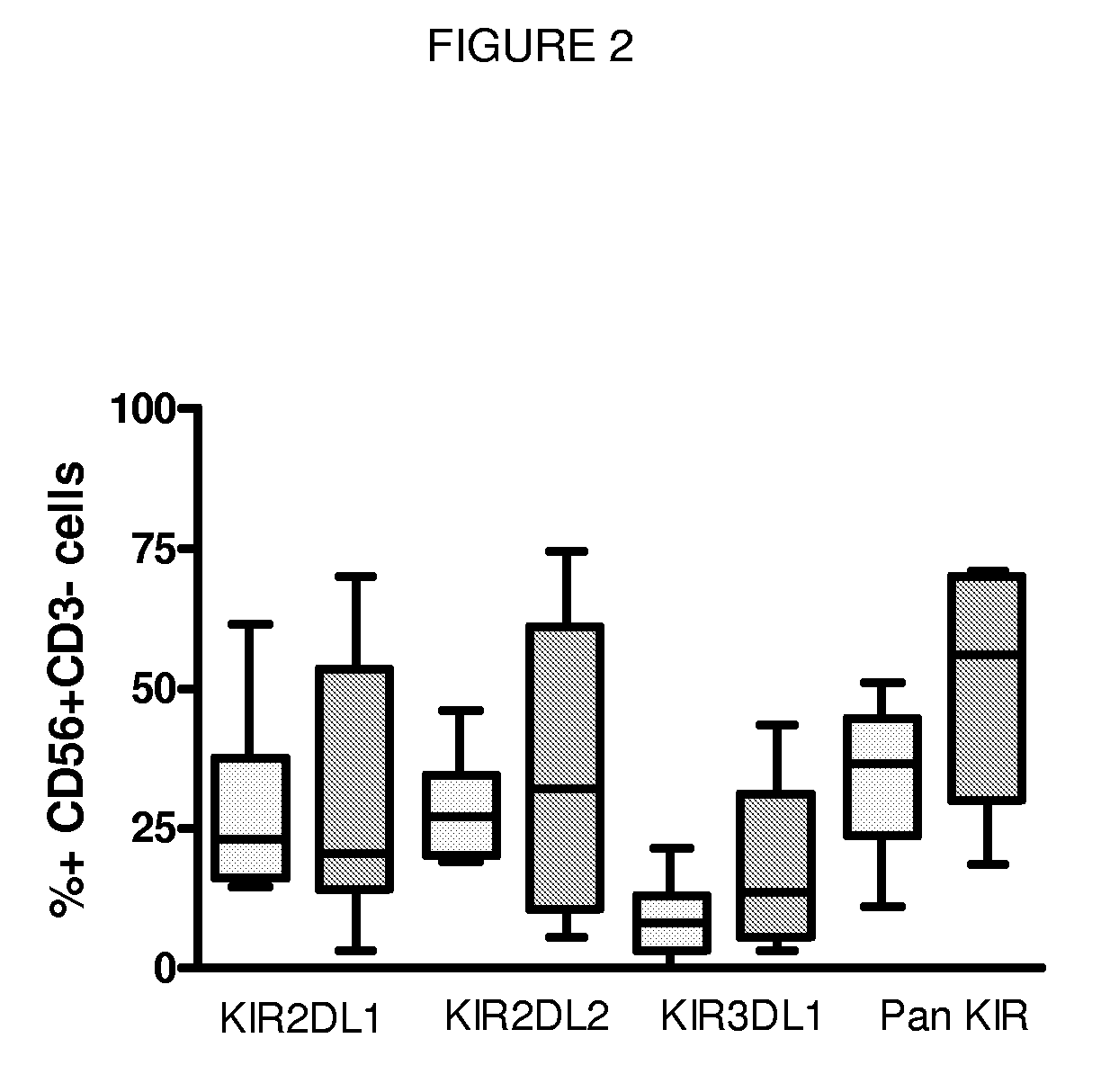Compositions and Methods for Treating Viral Infection
a technology for viral infections and compositions, applied in the field of compositions for treating viral infections, can solve the problems of not always showing a strong efficacy and the actual causes of treatment failure remain largely unknown, and achieve the effects of increasing the adcc mechanism, low and improving the efficacy of therapeutic antibodies
- Summary
- Abstract
- Description
- Claims
- Application Information
AI Technical Summary
Benefits of technology
Problems solved by technology
Method used
Image
Examples
example 1
Generation of a Pan KIR2DL Antibody
[0123]This Example describes the generation of murine monoclonal anti-KIR antibodies and the identification of DF200, a novel monoclonal antibody against a common determinant of KIR2DL human NK receptors.
Purification of PBLs and Generation of Polyclonal or Clonal NK Cell Lines
[0124]PBLs were derived from healthy donors by Ficoll Hypaque gradients and depletion of plastic adherent cells. To obtain enriched NK cells, PBLs were incubated with anti CD3, anti CD4 and anti HLA-DR mAbs (30 mns at 4° C.), followed by goat anti mouse magnetic beads (Dynal) (30 mns at 4° C.) and immunomagnetic selection by methods known in the art (Pende et al., J Exp Med. 1999; 190(10):1505-16. CD3 minus, CD4 minus DR minus cells are cultivated on irradiated feeder cells and 100 U / ml Interleukin 2 (Proleukin, Chiron Corporation) and 1.5 ng / ml Phytohemagglutinin A (Gibco BRL) to obtain polyclonal NK cell populations. NK cell are cloned by limiting dilution and clones of NK c...
example 2
Biacore Analysis of DF200 mAb / KIR 2DL1 and DF200 mAb / KIR 2DL3 Interactions
[0135]This Example describes an evaluation of the respective affinities of DF200 in binding to KIR2DL1 and KIR2DL3.
Production and Purification of Recombinant Proteins
[0136]The KIR 2DL1 and KIR 2DL3 recombinant proteins were produced in E. coli. cDNA encoding the entire extracellular domain of KIR 2DL1 and KIR 2DL3 were amplified by PCR from pCDM8 clone 47.11 vector (Biassoni et al, Eur J. Immunol. 1993; 23(5):1083-7; the disclosure of which is incorporated herein by reference) and RSVS(gpt)183 clone 6 vector (Wagtman et al., Immunity 1995 May; 2(5):439-49; the disclosure of which is incorporated herein by reference) respectively, using the following primers:
Sense:(SEQ ID NO:3)5′-GGAATTCCAGGAGGAATTTAAAATGCATGAGGGAGTCCACAG-3′Anti-sense:(SEQ ID NO:4)5′-CCCAAGCTTGGGTTATGTGACAGAAACAAGCAGTGG-3′
[0137]They were cloned into the pML1 expression vector in frame with a sequence encoding a biotinylation signal (Saulquin et...
example 3
Enhancement of ADCC by Using a Combination of Rituxan and Anti-KIR mAb
[0147]This experiment shows that Rituxan alone mediates essentially no ADCC by a KIR2DL1-positive NK clone on Cw4-positive target cells, while the ADCC of the KIR2DL1-positive clone is greatly enhanced in the presence of an anti-KIR2DL1 antibody.
Preparation of Human Nk Clones
[0148]Blood mononuclear cells depleted of T cells by negative anti-CD3 immuno-magnetic selection (Miltenyi) are plated under limiting-dilution conditions, activated with phytohemagglutinin (PHA) (Biochrom KG, Berlin, Germany), and cultured with interleukin (IL)-2 (Chiron B.V., Amsterdam, Netherlands) and irradiated feeder cells. Cloning efficiencies are equivalent in all donors and range between 1 in 5 and 1 in 10 plated NK cells. Cloned NK cells are screened for alloreactivity by standard 51Cr release cytotoxicity against Epstein-Barr virus-transformed B lymphoblastoid cell lines of known HLA type at an effector to target ratio of 10:1. Clone...
PUM
| Property | Measurement | Unit |
|---|---|---|
| time | aaaaa | aaaaa |
| time | aaaaa | aaaaa |
| time | aaaaa | aaaaa |
Abstract
Description
Claims
Application Information
 Login to View More
Login to View More - R&D
- Intellectual Property
- Life Sciences
- Materials
- Tech Scout
- Unparalleled Data Quality
- Higher Quality Content
- 60% Fewer Hallucinations
Browse by: Latest US Patents, China's latest patents, Technical Efficacy Thesaurus, Application Domain, Technology Topic, Popular Technical Reports.
© 2025 PatSnap. All rights reserved.Legal|Privacy policy|Modern Slavery Act Transparency Statement|Sitemap|About US| Contact US: help@patsnap.com



